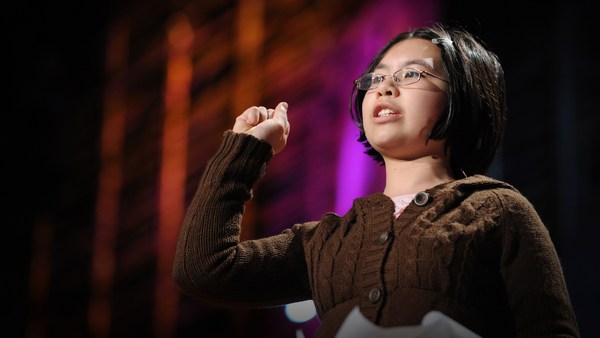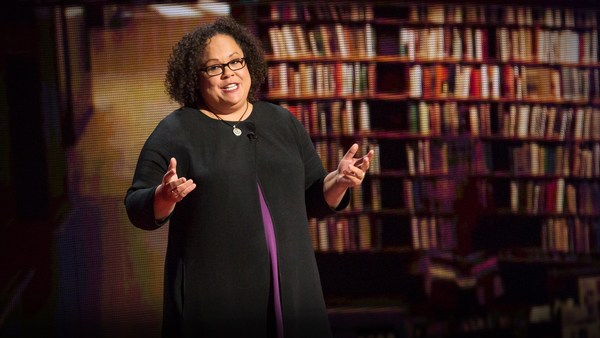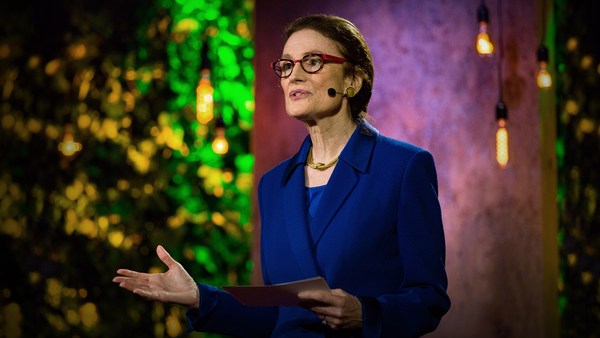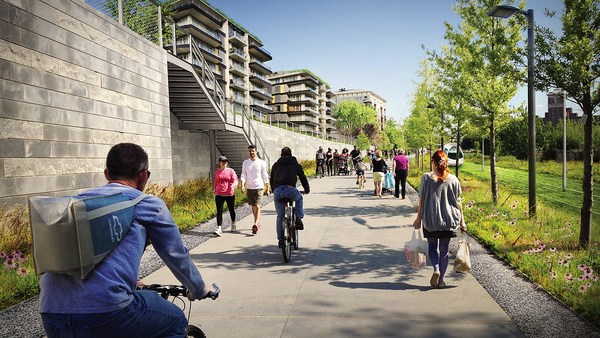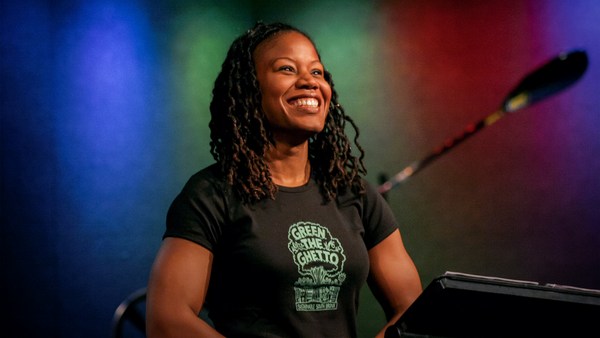Our society routinely makes decisions without consulting a quarter of the population. We're making choices about land use, energy production and natural resources without the ideas and experiences of the full community. The car, an inanimate object, has more say over public policy than this group of citizens. Can you guess which group I'm talking about? It's children.
I work in urban design, and not surprisingly, most cities are designed by adults. Urban planners, architects, developers, politicians, and occasionally, a few loud citizens. Rarely do you consider the voices of a group of four-year-olds, barely tall enough to reach the podium at city council chambers. But today, I want to ask you this: What would happen if we asked children to design our cities?
(Laughter)
Back in 2009, I was introduced to a small group of people who wanted to start a child-friendly city initiative in Boulder, Colorado. I come from a family of civil rights advocates, and I had spent my career until that point working with low-income children and families. But I had never heard of a child-friendly city initiative before. So I figured its purpose would be to address some of the frustrations I had encountered as the parent of a young child. Perhaps we would advocate for more changing tables in restaurants. Or create indoor play spaces for those cold and rainy days. In other words, make the city more hospitable to children and families. It wasn't until after I committed to this project that I realized I had it all wrong.
We wouldn't be designing better cities for children. Children would be designing better cities for themselves, and for the rest of us, too. Now, I bet you're skeptical about this idea. And honestly, I was, too. I mean, there must be a reason the voting age is 18.
(Laughter)
How could children possibly understand complex ideas such as the affordable housing crisis or how to develop a transportation master plan? And even if they had ideas, wouldn't they be childish? Or unreasonable? Do our cities really need a park made out of candy?
(Laughter)
Or a bridge with water cannons that fire water onto unsuspecting kayakers below?
(Laughter)
While these concerns sound legitimate, I realized that not including children in city planning was a bigger design problem. After all, shouldn't we include end users in the design process? If we're building a park to be largely used by kids, then kids should have a say in the park's design. So with all of this in mind, we formed a program called "Growing Up Boulder," and my job is to work with children ages zero through 18 to come up with innovative city-design solutions.
How do we do this, you might ask? Let me give you a real example. In 2012, the city of Boulder decided to redesign a large downtown park, known as the Civic Area. This space is bounded by a farmers' market on one end, Boulder Public Library on the other end, and by Boulder Creek, which runs through the middle. The space needed a new design to better handle the creek's inevitable flash floods, restore a sense of safety to the area and support an expanded farmers' market. So from 2012 through 2014, we engaged more than 200 young people in the process, ranging from preschool through high school students.
Now, how did we do this? Let me explain. First, we visited children in their classrooms and presented the project: what it was, why their ideas mattered and what would happen with their recommendations. Before we could influence them, we asked children to record their ideas, based on their own lived experiences. Then we asked children to go on a field trip with us, to document what they liked and didn't like about the space, using photography. Through green picture frames, students highlighted what they liked about the space, such as college students, tubing down the creek.
(Laughter)
Then they flipped those frames over and used the red side to highlight things they didn't like, such as trash. Our sixth-grade students studied the Civic Area by researching sites with similar challenges from around the world. Then, we invited the kids to combine their original ideas with their new inspiration, to synthesize solutions to improve the space. Each class invited adult planners, city council and community members into the classroom, to share and discuss their recommendations. Boulder's senior urban planners stepped over blocks and stuffed animals to explore preschool students' full-size classroom recreation of the Civic Area. Adult planners marveled at the students' ideas as they shared a park constructed out of a jelly bracelet. It was supposed to be an ice-skating rink. And then, public art constructed from animal-shaped plastic beads. And while this may seem ridiculous, it isn't so different from the models that architects create.
Now, fast-forward four years, and I am pleased to report that many of the children's ideas are being implemented in the Civic Area. For example, there will be improved access to Boulder Creek, so kids can play safely in the water. Lighting in previously dark underpasses, so high school students can walk home safely after school at night. And separated biking and walking paths, so speeding bikers won't hit young people as they stroll by the creek. My daughter and I even skated on a new, child-requested ice-skating rink, last winter.
So, were all of the kids' ideas implemented at the Civic Area? Of course not. Democracy is a messy process. But just as a reasonable and well-informed adult does not expect all of her ideas to be utilized, neither does a nine-year-old. We've now been using this process for eight years, and along the way, we've found some incredible benefits to designing cities with children. First of all, kids think differently from adults. And that's a good thing. Adults think about constraints, how much time will a project take, how much money will it cost and how dangerous will it be. In other words, "Are we going to get sued?"
(Laughter)
It's not that these constraints aren't real, but if we kill off ideas from the beginning, it limits our creativity and dampens the design process. Kids, on the other hand, think about possibilities. For kids, the sky is the limit. Literally. When we worked with middle-school students to design teen-friendly parks, they drew pictures of skydiving, hang gliding,
(Laughter)
and jumping from trampolines into giant foam pits.
(Laughter)
Some of this sounds far-fetched, but the commonalities among the activities revealed an important story. Our adolescents wanted thrill-seeking opportunities. Which makes perfect sense, given their developmental stage in life. So our task, as connectors between inspiration and reality, was to point them towards activities and equipment that actually could be installed in a park. This is exactly what parks in Australia have done, with their extensive zip lines and their 30-foot-tall climbing towers.
When kids dream up a space, they almost always include fun, play and movement in their designs. Now, this is not what adults prioritize. But research shows that fun, play and movement are exactly what adults need to stay healthy, too.
(Laughter)
Who wouldn't enjoy a tree house containing a little lending library and comfortable beanbag chairs for reading? Or what about a public art display that sprays paint onto a canvas each time you walk up the steps? In addition to fun and play, children value beauty in their designs. When tasked with designing dense affordable housing, kids rejected the blocks of identical, beige condominiums so many developers favor, and instead, put bright colors on everything, from housing to play equipment. They placed flowers between biking and walking paths, and placed benches along the creek, so kids could hang out with their friends and enjoy the tranquility of the water. Which leads me to nature. Children have a biological need to connect with nature, and this shows up in their designs. They want nature right in their backyards, not four blocks away. So they design communities that incorporate water, fruit trees, flowers and animals into their common spaces on site. For better or worse, this is logical, because five-year-olds today are rarely allowed to walk four blocks to access a park by themselves. And nature in one's immediate environment benefits everyone, since it has been shown to have restorative effects for all ages.
It may come as a surprise, but we even take into consideration the desires or our littlest citizens, babies and toddlers. From toddlers, we learned that the joy of walking comes from what you discover along the way. When they evaluated the walkability of Boulder's 19th Street corridor, toddlers spent long stretches exploring leaves in a ditch and sparkles in the sidewalk. They reminded us to slow down and design a path where the journey is as important as the destination. In addition to trees and plants, kids almost always include animals in their designs. Insects, birds and small mammals figure prominently into children's pictures. Whether it's because they're closer to the ground and can see the grasshoppers better than we can, or simply because they have a greater sense of empathy for other beings, children almost always include non-human species in their ideal worlds.
Across the board, children are inclusive in their city planning. They design for everyone, from their grandmother in a wheelchair to the homeless woman they see sleeping in the park. Children design for living creatures, not for cars, egos or corporations. The last and perhaps most compelling discovery we made is that a city friendly to children is a city friendly to all. Bogota, Colombia mayor Enrique Peñalosa observed that children are a kind of indicator species. If we can build a successful city for children, we will have a successful city for all people. Think about it.
Kids can't just hop in a car and drive to the store. And most kids can't afford an expensive lunch at the nearby cafe. So if we build cities that take into the consideration their needs for alternative forms of transportation and for cheaper food venues, we meet the needs of many other populations, too. The more frequent and more affordable bus service, so desired by our youth, also supports the elderly who wish to live independently, after they can no longer drive cars. Teens' recommendations for smooth, protected walking and skateboarding paths also support the person in a wheelchair who wishes to go smoothly down the path, or the parent pushing a new stroller.
So to me, all of this has revealed something important. An important blind spot. If we aren't including children in our planning, who else aren't we including? Are we listening to people of color, immigrants, the elderly and people with disabilities, or with reduced incomes? What innovative design solutions are we overlooking, because we aren't hearing the voices of the full community? We can't possibly know the needs and wants of other people without asking. That goes for kids and for everyone else. So, adults, let's stop thinking of our children as future citizens and instead, start valuing them for the citizens they are today. Because our children are designing the cities that will make us happier and healthier. Cities filled with nature, play, movement, social connection and beauty. Children are designing the cities we all want to live in.
Thank you.
(Applause)
